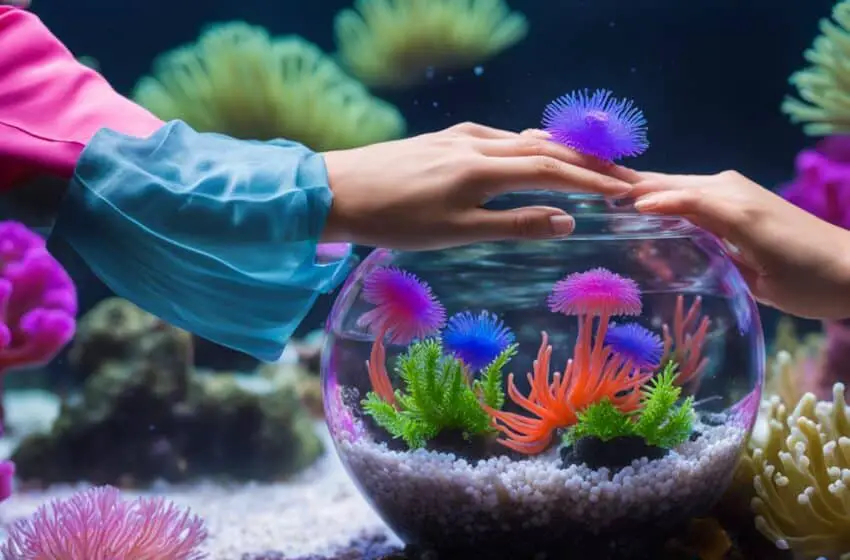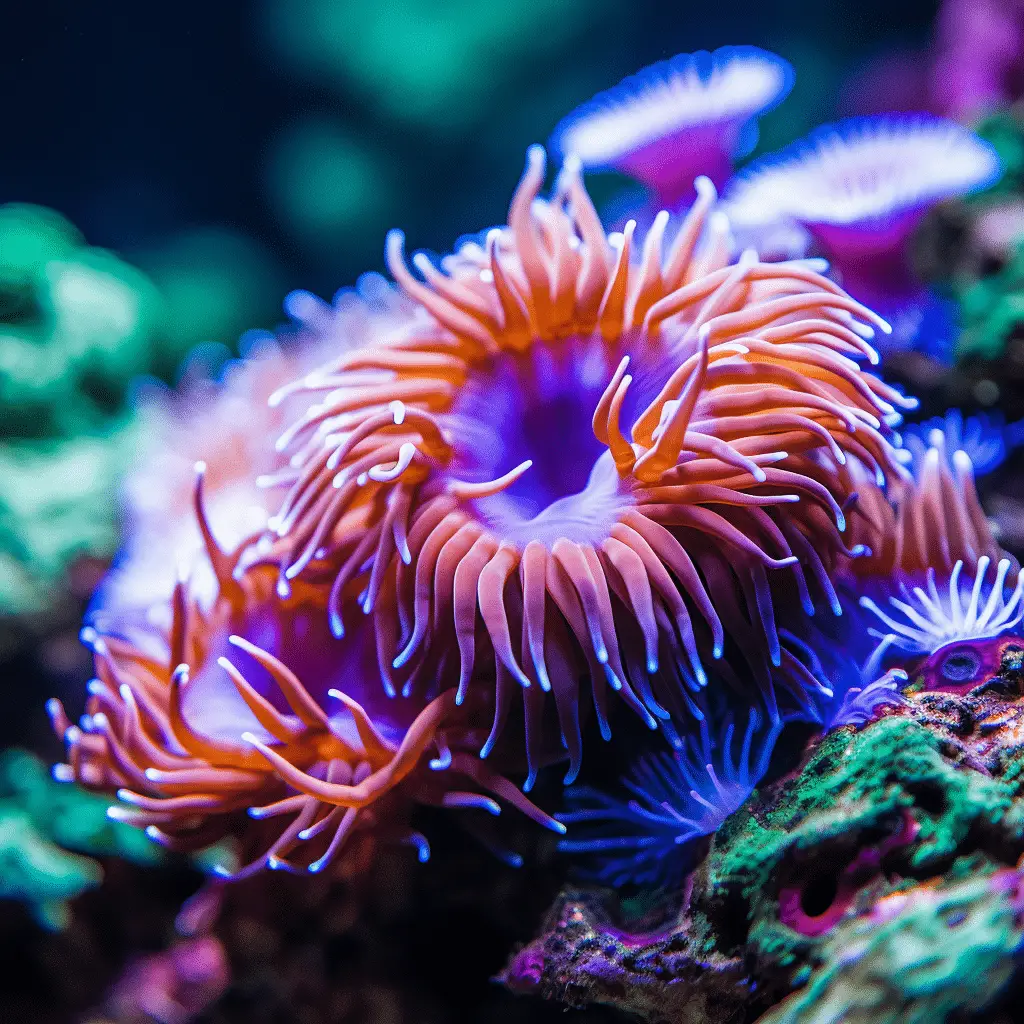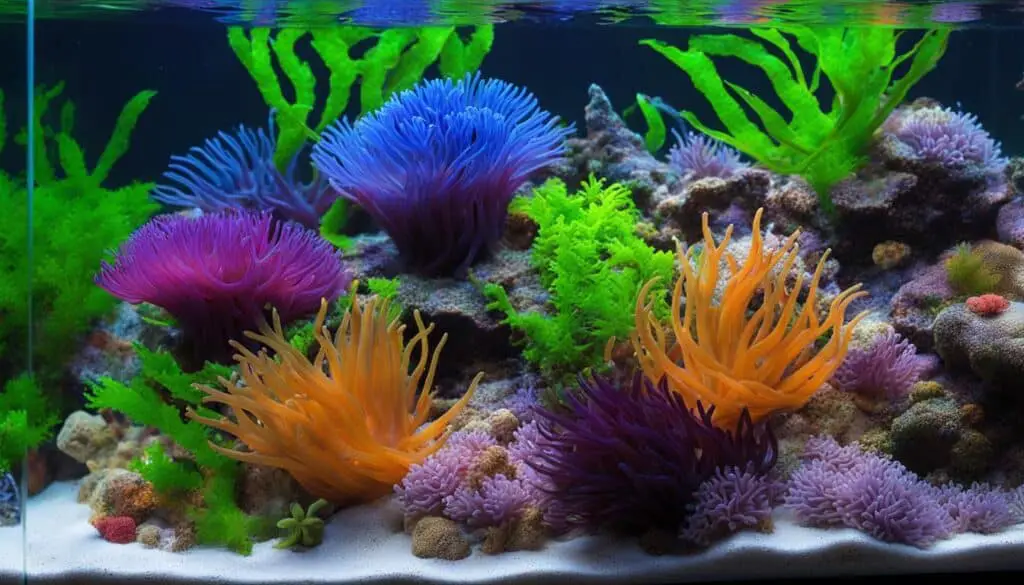Mastering Sea Anemone Care: Essential Tank Tips

Sea Anemone Care Tank Setup Feeding: Welcome to Sea Anemones 101, where I will guide you through the fascinating world of caring for these captivating creatures. Sea anemones, with their vibrant colors and graceful movements, are a beautiful addition to any saltwater aquarium Urchin Shells. But, to ensure their well-being and happiness, proper care is essential. In this article, I will share essential sea anemone care tips and highlight the key aspects of maintaining a sea anemone tank.
Key Takeaways:

- Sea anemones have symbiotic relationships with microorganisms, making their care unique.
- Recreating their natural environment in a tank is crucial for their health and longevity.
- Regular feeding, observing appetite and appearance, and avoiding overfeeding are vital for their well-being.
- Proper lighting and stable water conditions are essential for the photosynthetic microorganisms within the anemone.
- Creating a secure and spacious environment will ensure the happiness of your sea anemones.
Sea Anemone Tank Setup: Providing the Perfect Environment
Creating the ideal tank environment for sea anemones is crucial for their health and well-being. By replicating their natural habitat, you can ensure that they thrive in captivity.
- Water Requirements: Sea anemones require stable water conditions to thrive. Maintaining the appropriate temperature, salinity, and pH levels is essential. The water temperature should be between 75°F and 80°F (24°C-27°C), with a salinity level of 1.024-1.026 and a pH level of 8.1-8.4. Regular testing and adjustments are necessary to maintain optimal water quality.
- Protein Skimmer: To maintain water quality, it is recommended to use a protein skimmer. This device removes excess waste and organic compounds from the water, reducing the risk of ammonia and nitrate buildup. A protein skimmer helps keep the tank environment clean and healthy for sea anemones.
- Lighting: Proper lighting is essential for the photosynthetic microorganisms that live within sea anemones. LED lights are commonly used in aquariums to provide the appropriate spectrum and intensity. The lighting should be on a schedule that mimics natural day and night cycles to ensure the well-being of the sea anemones.
- Adequate Space and Hiding Spots: Sea anemones require ample space and hiding spots within the tank. Providing rock formations or other structures gives them a sense of security and allows them to retreat when necessary. Adequate space also prevents overcrowding, which can lead to territorial disputes among sea anemones.
Creating a suitable environment for sea anemones in your tank requires careful attention to water quality, lighting, and habitat. By providing the perfect conditions, you can ensure the health and longevity of these captivating marine creatures.

Table: Tank Requirements for Sea Anemones
| Water Parameters | Recommended Range |
|---|---|
| Temperature | 75°F – 80°F (24°C – 27°C) |
| Salinity | 1.024 – 1.026 |
| pH Level | 8.1 – 8.4 |
Sea Anemone Feeding Schedule: Nourishing your Anemones
Sea Anemone Care Tank Setup Feeding sea anemones is a vital part of their care and sustenance. To ensure the health and well-being of your anemones, it is crucial to establish a feeding schedule that meets their dietary needs. By following a proper feeding routine, you can help your anemones thrive in their aquarium habitat.
Once upon a time, in a far-off land, there was a magical kingdom under the sea. In this kingdom, there lived the most magnificent creatures – sea anemones! These beautiful beings were like flowers of the ocean, with their vibrant colors and delicate tentacles swaying in the current.
They wanted to bring the magic of these creatures to their own homes, so they decided to create a tank that would replicate their natural habitat.
The humans also knew that the sea anemones needed the perfect temperature and lighting to thrive. They installed special lights that mimicked the sun’s rays, and set the temperature to a comfortable 75 degrees. The anemones were so happy, they started dancing and swaying in the current, creating a mesmerizing underwater ballet.
But the humans didn’t stop there. They realized that sea anemones needed a healthy diet to keep their vibrant colors and energy. So, they carefully selected the best food for them – a mix of brine shrimp and plankton, fit for royalty.
Finally, the humans stepped back and admired their creation. The sea anemones were in a magical kingdom of their own, surrounded by all they needed to thrive. The humans were grateful for the opportunity to witness such beauty and vowed to protect the sea anemones and their kingdom forever.
And so, the sea anemones lived happily ever after, in their enchanted tank, enchanting all who gazed upon them with their whimsical beauty.
FAQ
How often should sea anemones be fed?
Sea anemones should be fed at least once a week, but some anemones may require more frequent feedings. It is important to observe the anemones and adjust the feeding schedule based on their appetite and appearance.
What should I feed my sea anemones?
Sea anemones can be fed a variety of small prey, including shrimp, fish, and mussels. It is recommended to provide a varied diet to ensure proper nutrition for the anemones.
How should I feed my sea anemones?
Feeding should be done using long tweezers or a feeding stick to avoid direct contact with the anemones’ stinging cells. This helps to prevent injury and discomfort for both the anemones and the caretaker.
How do I set up a tank for sea anemones?
When setting up a tank for sea anemones, it is important to recreate their natural environment as closely as possible. This includes providing stable water conditions with proper temperature, salinity, and pH levels. Lighting and hiding spots should also be provided to ensure the anemones feel secure.
Do sea anemones require special care in aquariums?
Yes, sea anemones do require special care in aquariums. They are sensitive animals that require specific water parameters and lighting conditions. Regular maintenance, such as removing excess waste and ensuring water quality, is necessary for their health and longevity.



